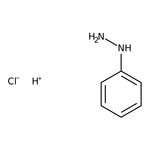Search Thermo Fisher Scientific
Phenylhydrazin, 97 %, Thermo Scientific Chemicals



Phenylhydrazin, 97 %, Thermo Scientific Chemicals
Chemikalien-Kennzeichnungen
Spezifikationen
Beschreibung
This Thermo Scientific Chemicals brand product was originally part of the Alfa Aesar product portfolio. Some documentation and label information may refer to the legacy brand. The original Alfa Aesar product / item code or SKU reference has not changed as a part of the brand transition to Thermo Scientific Chemicals.
Phenylhydrazin ist an der Fischer-Indol-Synthese zur Herstellung von Indolen beteiligt, die als Zwischenprodukte in den Pharmazeutika Anwendung finden, insbesondere für das Tryptamin-Medikament. In der analytischen Chemie wird es zur Differenzierung und Trennung von Zucker durch Bildung von Phenyhydrazonen verwendet. Es wird als N-schützendes Reagenz und zur Spaltung der Phthaloylgruppe verwendet.
Löslichkeit
Löslich in verdünnten Säuren.
Hinweise
Luft- und lichtempfindlich. Behälter an einem trockenen und gut belüfteten Ort dicht verschlossen halten. Nicht kompatibel mit Oxidationsmitteln.
Abbildungen
Dokumente und Downloads
Zertifikate
Häufig gestellte Fragen (FAQ)
Zitierungen und Referenzen
Sicherheit und Handhabung
Classification of the substance or mixture
CLP classification - Regulation(EC) No 1272/2008
Label Elements
Signal Word
Danger
Hazard Statements
H301 + H311 + H331 - Toxic if swallowed, in contact with skin or if inhaled
H315 - Causes skin irritation
H317 - May cause an allergic skin reaction
H319 - Causes serious eye irritation
H341 - Suspected of causing genetic defects
H350 - May cause cancer
H372 - Causes damage to organs through prolonged or repeated exposure
H400 - Very toxic to aquatic life
EU Specific Hazard Statements
Combustible liquid
Precautionary Statements
P273 - Avoid release to the environment
P280 - Wear protective gloves/protective clothing/eye protection/face protection
P301 + P310 - IF SWALLOWED: Immediately call a POISON CENTER or doctor/physician
P302 + P352 - IF ON SKIN: Wash with plenty of soap and water
P304 + P340 - IF INHALED: Remove person to fresh air and keep comfortable for breathing
P305 + P351 + P338 - IF IN EYES: Rinse cautiously with water for several minutes. Remove contact lenses, if present and easy to do. Continue rinsing
P311 - Call a POISON CENTER or doctor/physician
Additional EU labelling
Restricted to professional users